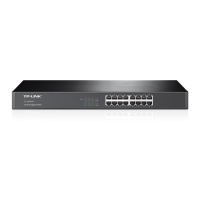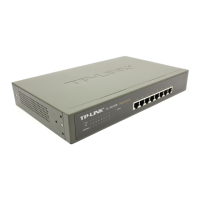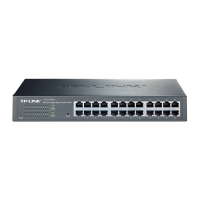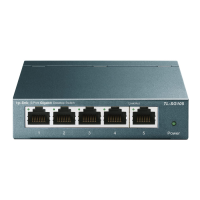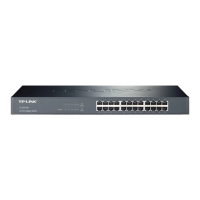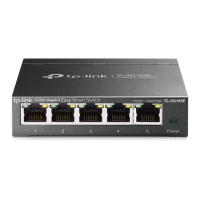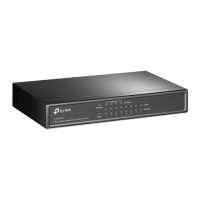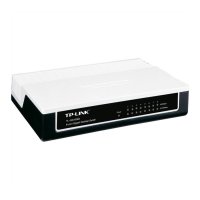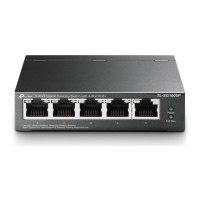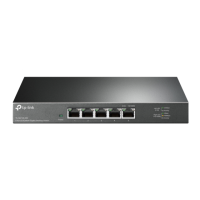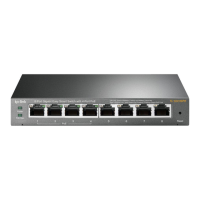Do you have a question about the TP-Link TL-SG1016PE and is the answer not in the manual?
Step-by-step guide on how to connect to and log into the switch's web interface for configuration.
Instructions for viewing system summary and specifying the device description for the switch.
Guide to setting the switch's IP address using DHCP or manually via the IP Setting menu.
Procedure to modify the administrator's username and password for enhanced security.
Steps to save the current switch configuration to a PC and restore it from a backup file.
Procedure to reset the switch to its factory default settings, clearing all configurations.
Instructions on how to download and install new firmware to update the switch's functionality.
Details the LAG function for aggregating multiple physical ports into a logical interface for higher bandwidth and reliability.
Guide to configuring port status, speed, duplex mode, and flow control for individual switch ports.
Steps to enable and configure IGMP Snooping for efficient multicast traffic management.
Instructions for creating and managing LAGs by selecting ports and assigning them to groups.
How to view detailed traffic statistics, packet counts, and link status for each port.
Steps to configure port mirroring to capture and analyze network traffic for troubleshooting.
Step-by-step guide on how to connect to and log into the switch's web interface for configuration.
Instructions for viewing system summary and specifying the device description for the switch.
Guide to setting the switch's IP address using DHCP or manually via the IP Setting menu.
Procedure to modify the administrator's username and password for enhanced security.
Steps to save the current switch configuration to a PC and restore it from a backup file.
Procedure to reset the switch to its factory default settings, clearing all configurations.
Instructions on how to download and install new firmware to update the switch's functionality.
Details the LAG function for aggregating multiple physical ports into a logical interface for higher bandwidth and reliability.
Guide to configuring port status, speed, duplex mode, and flow control for individual switch ports.
Steps to enable and configure IGMP Snooping for efficient multicast traffic management.
Instructions for creating and managing LAGs by selecting ports and assigning them to groups.
How to view detailed traffic statistics, packet counts, and link status for each port.
Steps to configure port mirroring to capture and analyze network traffic for troubleshooting.
| Total Power over Ethernet (PoE) budget | 110 W |
|---|---|
| Power over Ethernet (PoE) power per port | 30 W |
| Power over Ethernet plus (PoE+) ports quantity | 8 |
| 10G support | No |
| Number of VLANs | 4000 |
| Networking standards | IEEE 802.1Q, IEEE 802.1p, IEEE 802.3ab, IEEE 802.3i, IEEE 802.3u, IEEE 802.3x |
| Virtual LAN features | Tagged VLAN, Port-based VLAN |
| Cable types supported | Cat3, Cat4, Cat5, Cat5e, Cat6 |
| Copper ethernet cabling technology | 10BASE-T, 100BASE-TX, 1000BASE-T |
| Power connector | AC-in jack |
| Installed SFP modules quantity | 0 |
| Basic switching RJ-45 Ethernet ports type | Gigabit Ethernet (10/100/1000) |
| Basic switching RJ-45 Ethernet ports quantity | 16 |
| Switch type | Managed |
| Switch layer | L2 |
| Form factor | 1U |
| Product color | Black |
| Number of fans | 1 fan(s) |
| Housing material | Metal |
| Power source | AC/PoE |
| AC input voltage | 100 - 240 V |
| AC input frequency | 50/60 Hz |
| Power consumption (max) | 124.4 W |
| Jumbo frames | 10000 |
| Forwarding rate | 23.8 Mpps |
| Number of queues | 4 |
| MAC address table | 8000 entries |
| Packet buffer memory | 4.1 MB |
| Maximum cable length | 100 m |
| Compatible operating systems | Windows |
| Storage temperature (T-T) | -40 - 70 °C |
| Operating temperature (T-T) | 0 - 40 °C |
| Storage relative humidity (H-H) | 5 - 90 % |
| Operating relative humidity (H-H) | 10 - 90 % |
| Package type | Box |
| Package depth | 400 mm |
| Package width | 250 mm |
| Package height | 80 mm |
| Package weight | 2280 g |
| Cables included | AC |
| Sustainability certificates | CE, Federal Communications Commission (FCC), RoHS |
| Depth | 180 mm |
|---|---|
| Width | 294 mm |
| Height | 44 mm |
